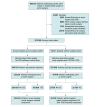Association of Intraoperative Transesophageal Echocardiography and Clinical Outcomes After Open Cardiac Valve or Proximal Aortic Surgery
- PMID: 35138396
- PMCID: PMC8829659
- DOI: 10.1001/jamanetworkopen.2021.47820
Association of Intraoperative Transesophageal Echocardiography and Clinical Outcomes After Open Cardiac Valve or Proximal Aortic Surgery
Abstract
Importance: Intraoperative transesophageal echocardiography (TEE) is used frequently in cardiac valve and proximal aortic surgical procedures, but there is a lack of evidence associating TEE use with improved clinical outcomes.
Objective: To test the association between intraoperative TEE use and clinical outcomes following cardiac valve or proximal aortic surgery.
Design, setting, and participants: This matched, retrospective cohort study used national registry data from the Society of Thoracic Surgeon (STS) Adult Cardiac Surgery Database (ACSD) to compare clinical outcomes among patients undergoing cardiac valve or proximal aortic surgery with vs without intraoperative TEE. Statistical analyses used optimal matching within propensity score calipers to conduct multiple matched comparisons including within-hospital and within-surgeon matches, a negative control outcome analysis, and sensitivity analyses. STS ACSD data encompasses more than 90% of all hospitals that perform cardiac surgery in the US. The study cohort consisted of all patients aged at least 18 years undergoing open cardiac valve repair or replacement surgery and/or proximal aortic surgery between 2011 and 2019. Statistical analysis was performed from October 2020 to April 2021.
Exposures: The exposure was receipt of intraoperative TEE during the cardiac valve or proximal aortic surgery.
Main outcomes and measures: The primary outcome was death within 30 days of surgery. The secondary outcomes were (1) a composite outcome of stroke or 30-day mortality and (2) a composite outcome of reoperation or 30-day mortality.
Results: Of the 872 936 patients undergoing valve or aortic surgery, 540 229 (61.89%) were male; 63 565 (7.28%) were Black and 742 384 (85.04%) were White; 711 326 (81.5%) received TEE and 161 610 (18.5%) did not receive TEE; the mean (SD) age was 65.61 years (13.17) years. After matching, intraoperative TEE was significantly associated with a lower 30-day mortality rate compared with no TEE: 3.81% vs 5.27% (odds ratio [OR], 0.69 [95% CI, 0.67-0.72]; P < .001), a lower incidence of stroke or 30-day mortality: 5.56% vs 7.01% (OR, 0.77 [95% CI, 0.74-0.79]; P < .001), and a lower incidence of reoperation or 30-day mortality: 7.18% vs 8.87% (OR, 0.78 [95% CI, 0.76-0.80]; P < .001). Results were similar across all matched comparisons (including within-hospital, within-surgeon matched analyses) and were robust to a negative control and sensitivity analyses.
Conclusions and relevance: Among adults undergoing cardiac valve or proximal aortic surgery, intraoperative TEE use was associated with improved clinical outcomes in this cohort study. These findings support routine use of TEE in these procedures.
Conflict of interest statement
Figures


References
Publication types
MeSH terms
LinkOut - more resources
Full Text Sources
Other Literature Sources
Medical
Miscellaneous

